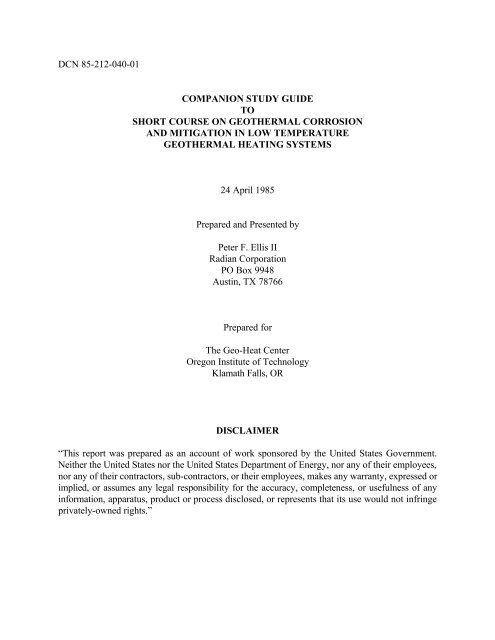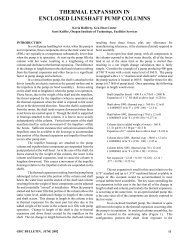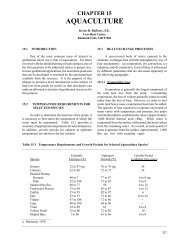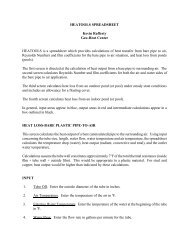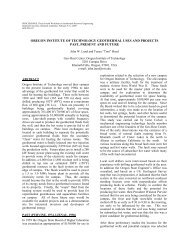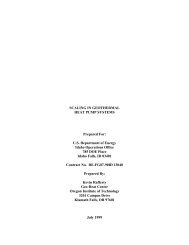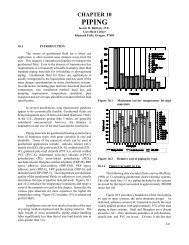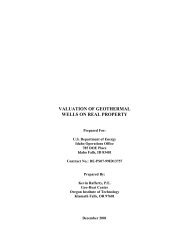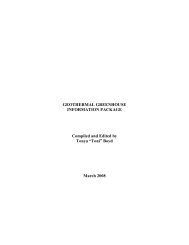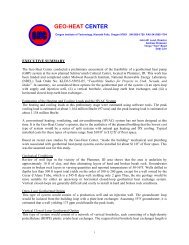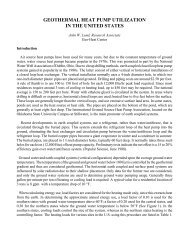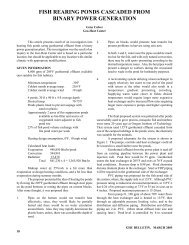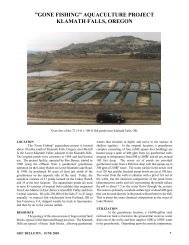Companion Study Guide on Short Course on Geothermal ... - OSTI
Companion Study Guide on Short Course on Geothermal ... - OSTI
Companion Study Guide on Short Course on Geothermal ... - OSTI
You also want an ePaper? Increase the reach of your titles
YUMPU automatically turns print PDFs into web optimized ePapers that Google loves.
DCN 85-212-040-01<br />
COMPANION STUDY GUIDE<br />
TO<br />
SHORT COURSE ON GEOTHERMAL CORROSION<br />
AND MITIGATION IN LOW TEMPERATURE<br />
GEOTHERMAL HEATING SYSTEMS<br />
24 April 1985<br />
Prepared and Presented by<br />
Peter F. Ellis II<br />
Radian Corporati<strong>on</strong><br />
PO Box 9948<br />
Austin, TX 78766<br />
Prepared for<br />
The Geo-Heat Center<br />
Oreg<strong>on</strong> Institute of Technology<br />
Klamath Falls, OR<br />
DISCLAIMER<br />
“This report was prepared as an account of work sp<strong>on</strong>sored by the United States Government.<br />
Neither the United States nor the United States Department of Energy, nor any of their employees,<br />
nor any of their c<strong>on</strong>tractors, sub-c<strong>on</strong>tractors, or their employees, makes any warranty, expressed or<br />
implied, or assumes any legal resp<strong>on</strong>sibility for the accuracy, completeness, or usefulness of any<br />
informati<strong>on</strong>, apparatus, product or process disclosed, or represents that its use would not infringe<br />
privately-owned rights.”
INTRODUCTION<br />
The ec<strong>on</strong>omic utilizati<strong>on</strong> of geothermal resources with temperatures less than 220 o F for<br />
purposes other than electric power generati<strong>on</strong> (direct utilizati<strong>on</strong>) requires creati<strong>on</strong> of systems with<br />
l<strong>on</strong>g plant life and minimum operati<strong>on</strong> and maintenance costs. Development of such systems requires<br />
careful corrosi<strong>on</strong> engineering if the most cost effective material selecti<strong>on</strong>s and design choices are to<br />
be made. This study guide presents guidelines for materials selecti<strong>on</strong> for low-temperature geothermal<br />
systems (120 - 200 o F), as well as guidance in materials design of heat pump systems for very-lowtemperature<br />
geothermal resources (less than 120 o F).<br />
This guideline is divided into five secti<strong>on</strong>s and an Appendix.<br />
1.0 Key Corrosive Species<br />
2.0 Modes of <strong>Geothermal</strong> Corrosi<strong>on</strong><br />
3.0 <strong>Geothermal</strong> Corrosivity Classificati<strong>on</strong> System<br />
4.0 Corrosi<strong>on</strong> Engineering of Low-Temperature Direct Utilizati<strong>on</strong> Systems<br />
5.0 <strong>Geothermal</strong> Heat Pumps<br />
Appendix Worksheets for Chemical and Scaling Properties of Low-Temperature<br />
<strong>Geothermal</strong> Waters<br />
These guidelines are based <strong>on</strong> Radian’s geothermal materials database, c<strong>on</strong>taining materials<br />
performance data from more than 20 low-temperature geothermal sites worldwide, as well as results<br />
of numerous comp<strong>on</strong>ent failure investigati<strong>on</strong>s c<strong>on</strong>ducted by Radian’s Materials Sciences Laboratory<br />
(MSL). Mush of this data is summarized in two DOE reports:<br />
Materials Selecti<strong>on</strong> <str<strong>on</strong>g>Guide</str<strong>on</strong>g>lines for <strong>Geothermal</strong> Energy Utilizati<strong>on</strong> Systems.<br />
and the Addendum to this report (the first two citati<strong>on</strong>s in the list of references).<br />
Unless otherwise indicated, the informati<strong>on</strong> herein is taken from these two documents.<br />
1.0 KEY CORROSIVE SPECIES<br />
<strong>Geothermal</strong> fluids comm<strong>on</strong>ly c<strong>on</strong>tain seven key chemical species that produce a significant<br />
corrosive effect. The key species are:<br />
• Oxygen (generally from aerati<strong>on</strong>)<br />
• Hydrogen i<strong>on</strong> (pH)<br />
• Chloride i<strong>on</strong><br />
• Sulfide species<br />
• Carb<strong>on</strong> dioxide species<br />
• Amm<strong>on</strong>ia species<br />
• Sulfate i<strong>on</strong>
The principal effects of these species are summarized in Table 1, except as noted, the<br />
described effects are for carb<strong>on</strong> steel.<br />
Two of these species are not reliably detected by standard water chemistry tests and deserve<br />
special note. Dissolved oxygen does not naturally occur in low-temperature (120 - 220 o F)<br />
geothermal waters which c<strong>on</strong>tain traces of hydrogen sulfide, though because of slow reacti<strong>on</strong> kinetics,<br />
oxygen from air inleakage may persist for some minutes. Preventing oxygen c<strong>on</strong>taminati<strong>on</strong> <strong>on</strong>ce the<br />
geofluid is produced is extremely difficult, especially if pumps other than downwell submersible<br />
pumps are used to move the geofluid. Even though the fluid system may be maintained at positive<br />
pressure, air inleakage at the pump seals is likely, particularly in light of the level of maintenance likely<br />
in many installati<strong>on</strong>s.<br />
Hydrogen sulfide is ubiquitous at low part-per-milli<strong>on</strong> (ppm) or part-per-billi<strong>on</strong> (ppb) levels<br />
in geothermal fluids above 120 o F. This corrosive species also occurs naturally in many cooler<br />
groundwaters. For those alloys such as cupr<strong>on</strong>ickels which are str<strong>on</strong>gly affected by it, hydrogen<br />
sulfide c<strong>on</strong>centrati<strong>on</strong>s in the low parts-per-billi<strong>on</strong> range may have a serious detrimental effect,<br />
especially if oxygen is also present. At these levels, the characteristic rotten egg odor of hydrogen<br />
sulfide may be absent, and detecti<strong>on</strong> requires use of field methods. Hydrogen sulfide levels down to<br />
50 ppb can be detected using a simple field kit provided by CHEMetrics. Even absence of hydrogen<br />
sulfide at this low level may not preclude damage by this species. Field spectrophotometry, which<br />
requires a spectrometer and different kit (K9503) has a detecti<strong>on</strong> limit of less than 10 ppb.<br />
Two other key species must also be measured in the field: pH and carb<strong>on</strong> dioxide species.<br />
This is necessary because most geothermal fluids will rapidly off-gas carb<strong>on</strong> dioxide, causing a rise<br />
in pH. DOE has published a manual for complete chemical analysis of geothermal well waters, giving<br />
recommended procedures (Kindle and Woodruff, 1981).<br />
2.0 MODES OF GEOTHERMAL CORROSION<br />
A number of different corrosive phenomena have been observed in geothermal systems. In<br />
low- and very-low-temperature geothermal systems, the following are most likely to be significant:<br />
Uniform corrosi<strong>on</strong> is the even wastage of metal from the comp<strong>on</strong>ent. This is the form of<br />
corrosi<strong>on</strong> which is expressed as a “corrosi<strong>on</strong> rate,” often mils/yr or mpy. Uniform corrosi<strong>on</strong> is a<br />
useful measure of corrosi<strong>on</strong> resistence <strong>on</strong>ly if the other modes of corrosi<strong>on</strong> described below do not<br />
occur.<br />
Pitting is localized corrosi<strong>on</strong> forming cavities or holes in the metal surface. The rate of pit<br />
penetrati<strong>on</strong> is highly unpredictable, and it is not practical to design around (or allow for) pitting.<br />
Pitting is particularly serious in heat exchangers (HX) because of the thin walls and large area of the<br />
HX, and because a single pin hole perforati<strong>on</strong> may c<strong>on</strong>stitute a failure.
Table 1. Principle Effects of the Key Corrosive Species<br />
Key Corrosive Species Principle Effects<br />
Oxygen Extremely corrosive to carb<strong>on</strong> and low allow steels. 30 ppb* shown to cause four-fold<br />
increase in carb<strong>on</strong> steel corrosi<strong>on</strong> rate.<br />
C<strong>on</strong>centrati<strong>on</strong> above 50 ppb cause serious pitting.<br />
In c<strong>on</strong>juncti<strong>on</strong> with chloride and high temperature, less than 100 ppb dissolved oxygen<br />
can cause chloride-stress corrosi<strong>on</strong> cracking (chloride-SCC) of some austenitic stainless<br />
steels.<br />
Hydrogen i<strong>on</strong> (pH) Primary cathodic reacti<strong>on</strong> of steel corrosi<strong>on</strong> in air-free brine is hydrogen i<strong>on</strong><br />
reducti<strong>on</strong>. Corrosi<strong>on</strong> rate decreases sharply above pH 8.<br />
Carb<strong>on</strong> dioxide species<br />
(dissolved carb<strong>on</strong> dioxide,<br />
bicarb<strong>on</strong>ate i<strong>on</strong>, carb<strong>on</strong>ate i<strong>on</strong>)<br />
Hydrogen sulfide species<br />
(hydrogen sulfide, bisulfide i<strong>on</strong>,<br />
sulfide i<strong>on</strong>)<br />
Amm<strong>on</strong>ia species<br />
(amm<strong>on</strong>ia, amm<strong>on</strong>ium i<strong>on</strong>)<br />
Low pH (less than about 5) promotes sulfide stress cracking (SSC) of high strength<br />
low alloy (HSLA) steels and some other alloys coupled to steel.<br />
Low pH may cause breakdown of passivity of stainless steels.<br />
Acid attack <strong>on</strong> cements.<br />
Dissolved carb<strong>on</strong> dioxide lowers pH, increasing carb<strong>on</strong> and HSLA steel corrosi<strong>on</strong>.<br />
Dissolved carb<strong>on</strong> dioxide provides alternative prot<strong>on</strong> reducti<strong>on</strong> pathway, further<br />
exacerbating carb<strong>on</strong> and HSLA steel corrosi<strong>on</strong>.<br />
May exacerbate SSC.<br />
Str<strong>on</strong>g link between total alkalinity and corrosi<strong>on</strong> of steel in low-temperature<br />
geothermal wells.<br />
Potent cathodic pois<strong>on</strong>, promoting SSC of HSLA steels and some other alloys coupled<br />
to steel.<br />
Highly corrosive to alloys c<strong>on</strong>taining both copper and nickel in any proporti<strong>on</strong>s.<br />
May cause an (active path) chloride-sulfide-SCC of nickel-based alloys at high<br />
temperatures.<br />
Causes SCC of some copper-based alloys.<br />
Chloride i<strong>on</strong> Str<strong>on</strong>g promoter of localized corrosi<strong>on</strong> of carb<strong>on</strong>, HSLA, and stainless steels as well<br />
as of other alloys.<br />
Chloride dependent threshold temperature for pitting and SCC. Different for each<br />
alloy.<br />
Little if any effect <strong>on</strong> SSC.<br />
Steel passivates at high temperatures in pH 5, 6070 ppm chloride soluti<strong>on</strong> with<br />
carb<strong>on</strong> dioxide. 133,500 ppm chloride destroys passivity above 300 o F.<br />
Sulfate i<strong>on</strong> Primary effect is corrosi<strong>on</strong> of cements.<br />
* Parts per billi<strong>on</strong>
Crevice corrosi<strong>on</strong> is similar to pitting except that it occurs in geometrically c<strong>on</strong>fined spaces<br />
such as the crevices where tube and tubesheet join, where the plate ridges of flat plate heat<br />
exchangers (PHXs) overlap or under scale deposits. Like pitting, the rate of crevice corrosi<strong>on</strong><br />
penetrati<strong>on</strong> is unpredictable, and it is not possible to design around it.<br />
Stress corrosi<strong>on</strong> cracking is the cracking of an alloy as a result of the interacti<strong>on</strong> of stress,<br />
applied or residual from forming and fabricati<strong>on</strong>, and a specific envir<strong>on</strong>mental factor. For example,<br />
some stainless steels are crackled by chlorides under certain c<strong>on</strong>diti<strong>on</strong>s (chloride-SCC) and some<br />
copper alloys are so attacked by traces of amm<strong>on</strong>ia (amm<strong>on</strong>ia-SCC). A special case of SCC can<br />
result when high strength low alloy (HSLA) steels are exposed under stress to waters c<strong>on</strong>taining<br />
hydrogen sulfide. This particular form of SCC is comm<strong>on</strong>ly called sulfide stress cracking (SSC).<br />
Erosi<strong>on</strong>-corrosi<strong>on</strong> is the highly accelerated corrosi<strong>on</strong> of an alloy exposed to a corrosive<br />
soluti<strong>on</strong> flowing faster than a critical velocity peculiar to that alloy. Characteristically, corrosi<strong>on</strong> is<br />
mild at lower velocities.<br />
Inter-granular corrosi<strong>on</strong> occurs when the grain boundaries of the metallic microstructure<br />
corrode preferentially, causing the grains to fall out. This process can occur in austenitic stainless<br />
steels in low- temperature geothermal envir<strong>on</strong>ments, but <strong>on</strong>ly if the stainless steel is defective in heat<br />
treatment or is improperly welded.<br />
Galvanic corrosi<strong>on</strong> is the accelerated corrosi<strong>on</strong> of <strong>on</strong>e metal resulting from its electrical<br />
c<strong>on</strong>tact with a different metal. The most comm<strong>on</strong> example is steel coupled to copper, resulting in<br />
accelerated corrosi<strong>on</strong> of the steel.<br />
Dealloying is the selective leaching <strong>on</strong> <strong>on</strong>e c<strong>on</strong>stituent element of an alloy, without change<br />
in the gross shape of the comp<strong>on</strong>ent. Three forms have been observed in low-temperature<br />
geothermal comp<strong>on</strong>ents: dezincificati<strong>on</strong> of yellow brass, graphitizati<strong>on</strong> of cast ir<strong>on</strong> (the ir<strong>on</strong> is<br />
removed leaving the carb<strong>on</strong> matrix), and deplumbificati<strong>on</strong> (removal of lead) from a lead-tin solder.<br />
3.0 GEOTHERMAL CORROSIVITY CLASSIFICATION SYSTEM<br />
While developing the Materials Selecti<strong>on</strong> <str<strong>on</strong>g>Guide</str<strong>on</strong>g>lines for <strong>Geothermal</strong> Energy Utilizati<strong>on</strong><br />
Systems, Radian invented a <strong>Geothermal</strong> Corrosivity Classificati<strong>on</strong> System that divided the<br />
currently developed geothermal resources into six classes based <strong>on</strong> key corrosive species, wellhead<br />
temperature, and similarities of corrosi<strong>on</strong> behavior. This classificati<strong>on</strong> system does not eliminate the<br />
need for site specific evaluati<strong>on</strong> of corrosi<strong>on</strong> problems; but does allow some generalizati<strong>on</strong> about<br />
materials performance and design requirements.<br />
Subsequent informati<strong>on</strong> lead to the divisi<strong>on</strong> of Class V, the class c<strong>on</strong>taining low-temperature<br />
geothermal resources, into two sub-classes, Class Va and Class Vb. This divisi<strong>on</strong> was based <strong>on</strong><br />
statistical evaluati<strong>on</strong> of carb<strong>on</strong> steel corrosi<strong>on</strong> data from 29 separate tests in different resources (Ellis,<br />
1982). Tables 2 and 3 summarize the characteristics of these two corrosivity systems sub-classes.
Table 2. <strong>Geothermal</strong> Resources Corrosivity Class Va<br />
______________________________________________________________________________<br />
Defining Parameters<br />
Resource type Liquid-dominated<br />
Total key species (TKS) a Less than 5,000 ppm<br />
Chloride fracti<strong>on</strong> in TKS 3 to 72 percent<br />
Total alkalinity 207-1329 ppm CaCO 3<br />
pH (unflashed fluid) 6.7 - 7.6<br />
pH (flashed fluid) Not applicable<br />
Vol. gas in stream Not applicable<br />
Plant inlet temperature 120 to 205 o F<br />
Resource temperature Same<br />
Sites Reviewed<br />
Madis<strong>on</strong> Aquifer, SD (3 sites)<br />
Pagosa Springs, CO<br />
Marlin, TX<br />
Corrosi<strong>on</strong> of Carb<strong>on</strong> Steel<br />
• In n<strong>on</strong>-aerated produced fluid, the median uniform (weight-loss) corrosi<strong>on</strong> rate is 12.5 mpy,<br />
with a probable range (95 percent c<strong>on</strong>fidence limits) of 4.9 mpy - 20.2 mpy.<br />
• One of nine tests showed no pitting, others showed severe pitting as high as 83 mpy.<br />
• Aerati<strong>on</strong> may cause a 4- to 15-fold increase in weight-loss corrosi<strong>on</strong> as pitting.<br />
General Performance of Other Alloys<br />
• In n<strong>on</strong>-aerated fluid, uniform corrosi<strong>on</strong> of copper in heat transfer service is 1 to 10 mpy with<br />
severe crevice corrosi<strong>on</strong> under corrosi<strong>on</strong> product scale. Brasses and cupr<strong>on</strong>ickels are less<br />
suitable than copper for heat transfer.<br />
• Type 316 stainless steel is resistant to uniform corrosi<strong>on</strong>, pitting and crevice corrosi<strong>on</strong>, and<br />
stress corrosi<strong>on</strong> cracking in many applicati<strong>on</strong>s.<br />
_____________________________<br />
a. Total chloride + sulfide + carb<strong>on</strong> dioxide species + sulfide species + amm<strong>on</strong>ia species in<br />
produced fluid.<br />
______________________________________________________________________________
Table 3. <strong>Geothermal</strong> Resources Corrosivity Class Vb<br />
______________________________________________________________________________<br />
Defining Parameters<br />
Resource type Liquid-dominated<br />
Total key species (TKS) a Less than 5000 ppm<br />
Chloride fracti<strong>on</strong> in TKS 3 to 72 percent<br />
Total alkalinity Less than 210 ppm CaCO 3<br />
pH (unflashed fluid) 7.8 - 9.85<br />
pH (flashed fluid) Not applicable<br />
Vol. gas in stream Not applicable<br />
Plant inlet temperature 120 to 205 o F<br />
Resource temperature Same<br />
Sites Reviewed in the <str<strong>on</strong>g>Guide</str<strong>on</strong>g>lines<br />
Iceland (15 sites)<br />
USA - Klamath Falls, OR (5 wells)<br />
Corrosi<strong>on</strong> of Carb<strong>on</strong> Steel<br />
• In n<strong>on</strong>-aerated produced fluid, the median uniform (weight-loss) corrosi<strong>on</strong> rate is 0.12 mpy<br />
with an upper limit (95 percent c<strong>on</strong>fidence) of 1.65 mpy.<br />
• Pitting - 28 percent no detectable pitting. Additi<strong>on</strong>al 40 percent pitted at less than 5 mpy.<br />
Maximum observed pitting rate was 20 mpy.<br />
• Aerati<strong>on</strong> may cause a 4- to 15-fold increase in weight-loss corrosi<strong>on</strong> with probably heavy<br />
pitting.<br />
General Performance of Other Alloys<br />
• In n<strong>on</strong>-aerated fluid, uniform corrosi<strong>on</strong> of copper in heat transfer service is 1 to 10 mpy with<br />
severe crevice corrosi<strong>on</strong> under corrosi<strong>on</strong> product scale. Brasses and cupr<strong>on</strong>ickels are less<br />
suitable than copper for heat transfer.<br />
• Type 316 stainless steel is resistant to uniform corrosi<strong>on</strong>, pitting and crevice corrosi<strong>on</strong>, and<br />
stress corrosi<strong>on</strong> cracking in many applicati<strong>on</strong>s.<br />
_____________________________<br />
a. Total chloride + sulfate + carb<strong>on</strong> dioxide species + sulfide species + amm<strong>on</strong>ia species in<br />
produced fluid.<br />
_______________________________________________________________________________
4.0 CORROSION ENGINEERING FOR LOW-TEMPERATURE GEOTHERMAL<br />
SYSTEMS<br />
4.1 Performance of Materials<br />
Carb<strong>on</strong> Steel<br />
For many years, the Ryznar Index (discussed in the Appendix), has been used to estimate the<br />
corrosivity and scaling tendencies of potable water supplies. However, the statistical study discussed<br />
in Secti<strong>on</strong> 3 found no significant correlati<strong>on</strong> (at the 95 percent c<strong>on</strong>fidence level) between carb<strong>on</strong> steel<br />
corrosi<strong>on</strong> and Ryznar Index. Therefore, the Ryznar Index, and other indices based <strong>on</strong> calcium<br />
carb<strong>on</strong>ate saturati<strong>on</strong>, should not be used to predict corrosi<strong>on</strong>. The Ryznar Index may be predictive<br />
of calcium carb<strong>on</strong>ate scaling tendencies.<br />
Table 2 summarizes the expected performance of carb<strong>on</strong> steel in Class Va geothermal fluids.<br />
Under these c<strong>on</strong>diti<strong>on</strong>s, corrosi<strong>on</strong> rates of about 5 to 20 mpy can be expected, often with severe<br />
pitting.<br />
Table 3 summarizes the expected performance of carb<strong>on</strong> steel in Class Vb geothermal fluids.<br />
Carb<strong>on</strong> steel piping has given good service in a number of systems, provided the system design<br />
rigorously excludes oxygen. However, introducti<strong>on</strong> of 30 ppb oxygen under turbulent flow<br />
c<strong>on</strong>diti<strong>on</strong>s causes a four-fold increase in uniform corrosi<strong>on</strong>. Saturati<strong>on</strong> with air often increases the<br />
corrosi<strong>on</strong> rate at least 15-fold. Oxygen c<strong>on</strong>taminati<strong>on</strong> at the 50 ppb level often causes severe pitting.<br />
Chr<strong>on</strong>ic oxygen c<strong>on</strong>taminati<strong>on</strong> causes rapid failure. These fluids are characteristic of those used by<br />
Icelandic district heating systems. In those systems, steel piping has been generally successful, but<br />
carb<strong>on</strong> steel shell-and-tube heat exchangers have been satisfactory <strong>on</strong>ly in systems where 10 ppm<br />
excess sodium sulfite is added c<strong>on</strong>tinuously as an oxygen scavenger.<br />
In the case of buried steel pipe, it is critical that the external surfaces be protected from<br />
c<strong>on</strong>tact with groundwater. Such groundwater is aerated, and has caused pipe failures by external<br />
corrosi<strong>on</strong> in a least two U.S. systems. Required external protecti<strong>on</strong> can be obtained by use of<br />
coatings or pipe-wrap, provided the selected material will resist the system operating temperatures<br />
and thermal stresses.<br />
At temperatures above 135 o F, galvanizing (zinc coating) will not protect steel from either<br />
geothermal or groundwater.<br />
Hydrogen sulfide inhibits the reacti<strong>on</strong> of atomic hydrogen <strong>on</strong> the steel surface, itself a product<br />
of the prot<strong>on</strong> reducti<strong>on</strong> step of the corrosi<strong>on</strong> processes, to form molecular hydrogen. The atomic<br />
hydrogen enters the steel lattice and, in the case of carb<strong>on</strong> (mild) steels, accumulates as molecular<br />
hydrogen in microvoilds, causing hydrogen blistering. Hydrogen blistering can be prevented by use<br />
of vold-free, or “killed” steels.
Low alloy steels (steels c<strong>on</strong>taining not more than four percent alloying elements) have<br />
corrosi<strong>on</strong> resistance similar, in most respects, to carb<strong>on</strong> steels. As in the case of carb<strong>on</strong> steels, sulfide<br />
promotes entry of atomic hydrogen into the metal lattice. If the steel exceeds Hardness Rockwell<br />
C22, sulfide stress cracking may occur.<br />
Copper and Copper Alloys<br />
Copper fan-coil units and copper-tubed heat exchangers have a c<strong>on</strong>sistently poor performance<br />
in U.S. geothermal fluids due to the presence of traces of sulfide species. Copper tubing rapidly<br />
becomes fouled with cuprous sulfide films more than 0.4 inches thick. Serious crevice corrosi<strong>on</strong><br />
occurs at cracks in the film and, uniform corrosi<strong>on</strong> rates of 2 - 6 mpy appear typical, based <strong>on</strong> failure<br />
analyses. These corrosi<strong>on</strong> rates were measured by coup<strong>on</strong>s in low velocity (1 ft/sec) fluid at the same<br />
or similar resources.<br />
Experience in Iceland also indicates that for heat exchange service, copper is unsatisfactory<br />
and most brasses (Cu-Zn) and br<strong>on</strong>zes (Cu-Sn) are still less suitable. Cupr<strong>on</strong>ickels can be expected<br />
to perform more poorly than copper in low-temperature geothermal service because of trace sulfide.<br />
Much less informati<strong>on</strong> is available about copper and copper alloys in n<strong>on</strong>-heat-transfer service.<br />
Copper pipe shows corrosi<strong>on</strong> behavior similar to copper heat exchange tubes under c<strong>on</strong>diti<strong>on</strong>s of<br />
moderate turbulence (Reynolds numbers of 40,000 - 70,000). The internals of the few yellow brass<br />
valves analyzed by Radian showed no significant corrosi<strong>on</strong>. However, silic<strong>on</strong> br<strong>on</strong>ze CA 875 (12-16-<br />
CR, 3-5-Si,
corrosi<strong>on</strong> resistance, is ruptured in local areas and/or in crevices. These ruptured area then corrode<br />
in the form of pitting and crevice corrosi<strong>on</strong>. Figure 1 shows the relati<strong>on</strong>ship between temperature,<br />
chloride, and occurrence of localized corrosi<strong>on</strong> of Type 304 and Type 316. For example, this figure<br />
indicates that localized corrosi<strong>on</strong> of Type 304 may occur in 80 o F geofluid if the chloride level exceeds<br />
around 210 ppm; while, Type 316 is resistant at that temperature until the chloride level reaches about<br />
510 ppm. Type 316, as shown in Figure 1, is always more resistant to chlorides than is Type 304,<br />
due to its 2 - 3 percent molybdenum (Mo) c<strong>on</strong>tent. The fact that localized corrosi<strong>on</strong> can occur does<br />
not predict the rate, but <strong>on</strong>e should expect more severe attack as the chloride-temperature c<strong>on</strong>diti<strong>on</strong>s<br />
intrude further and further into the localized corrosi<strong>on</strong> regi<strong>on</strong>. These alloys can be used in this regi<strong>on</strong>,<br />
provided that oxygen is rigorously excluded, but there would be a risk of rapid failure should even<br />
traces of oxygen intrude.<br />
These alloys can also fail by stress corrosi<strong>on</strong> cracking above about 140 o F. In practice,<br />
however, no such failures have, to Radian’s knowledge, occurred in low-temperature (120 - 220 o F)<br />
geothermal applicati<strong>on</strong>s. As a precauti<strong>on</strong>, heat exchanger plates should be stress relieved after<br />
forming.<br />
Other austenitic stainless steels with increased chromium and molybdenum c<strong>on</strong>tents,<br />
compared to Type 316, can be expected to be resistant to pitting, crevice corrosi<strong>on</strong>, and stress<br />
corrosi<strong>on</strong> cracking under virtually any c<strong>on</strong>diti<strong>on</strong>s encountered with resources of this fluid class, but<br />
are not routinely available as HX plates.<br />
N<strong>on</strong>-austenitic stainless steels are generally resistant to chloride stress corrosi<strong>on</strong> cracking.<br />
But many, especially grades c<strong>on</strong>taining about 12 percent chromium and less than two percent<br />
molybdenum, will probably pit severely, especially in aerated envir<strong>on</strong>ments. More highly alloyed<br />
“super ferritics” offer c<strong>on</strong>siderable promise but have not been tested in these envir<strong>on</strong>ments. Type 444<br />
(18Cr-2Mo) has pitting resistance similar to Type 316. SeaCure (26Cr-3Mo), Allegheny-Ludium 29-<br />
4 (29Cr-4Mo) and Allegheny-Ludium 29-4-2 (29Cr-4Mo-2Ni) should resist any envir<strong>on</strong>ment<br />
resulting from use of fluids of this class. ASTM XM27 (26Cr-1Mo) is of intermediate resistance.<br />
All these alloys resist chloride stress corrosi<strong>on</strong> cracking.<br />
Aluminum<br />
<strong>Geothermal</strong> experience to date indicates that aluminum alloys will not be acceptable in most<br />
cases because of catastrophic pitting.<br />
Titanium<br />
This material has extremely good corrosi<strong>on</strong> resistance and should serve as heat exchanger<br />
plates in any low-temperature geothermal fluid, regardless of dissolved oxygen c<strong>on</strong>tent. Great care<br />
is required if acid cleaning is to be performed. The vendor’s instructi<strong>on</strong>s must be adhered to. In<br />
additi<strong>on</strong>, care must be taken to avoid scratching the titanium with ir<strong>on</strong> or steel tools, since this can<br />
cause pitting.
Figure 1. Chloride required to produce localized corrosi<strong>on</strong> of Type 304 and Type 316<br />
as a functi<strong>on</strong> of temperature (Data from Efird and Moller, 1978).<br />
Note: The lines are linear regressi<strong>on</strong> best fits having correlati<strong>on</strong> factors $ 0.98.<br />
CPVC (Chlorinated Polyvinyl Chloride) and FRP (Fiber Reinforced Plastic)<br />
These materials offer ease of fabricati<strong>on</strong> and are not adversely affected by oxygen<br />
intrusi<strong>on</strong>. External protecti<strong>on</strong> against groundwater is not required. Their mechanical properties<br />
at higher temperatures may vary greatly from ambient temperature properties and care must be<br />
exercised not to exceed the mechanical limits of the materials. The usual mode of failure is creep<br />
rupture and the creep rupture strength decays with time. Design data are available from<br />
manufacturers, based <strong>on</strong> extrapolati<strong>on</strong> of 10,000-hour test results to 100,000 hours. The effect<br />
<strong>on</strong> mechanical properties of exposures l<strong>on</strong>ger than 100,000 hours is not known.<br />
The manufacturer’s directi<strong>on</strong>s for joining must be followed explicitly to avoid premature<br />
failure of joints.<br />
Elastomeric Seals<br />
Tests of O-ring materials by Radian in a low-temperature system in Texas, indicate that<br />
Vit<strong>on</strong> is the best material with Buna-N being acceptable. Neoprene, which developed extreme<br />
compressi<strong>on</strong> set, was a failure. Natural rubber and Buna-S should also be avoided.
4.2 Corrosi<strong>on</strong> Engineering and Design<br />
The design of the geothermal system is as critical in c<strong>on</strong>trolling corrosi<strong>on</strong> as the selecti<strong>on</strong> of<br />
suitable materials. Furthermore, the design/material selecti<strong>on</strong> process is interactive in that certain<br />
design decisi<strong>on</strong>s force the use of certain materials; while, selecti<strong>on</strong> of materials may dictate design.<br />
In all cases, the objective should be the same: to produce an adequately reliable system with the<br />
lowest possible life-time cost.<br />
Three basic corrosi<strong>on</strong> engineering design philosophies for geothermal systems are apparent:<br />
1. Use corrosi<strong>on</strong> resistant materials throughout the system,<br />
2. Exclude or remove oxygen and use carb<strong>on</strong> steel throughout the system.<br />
3. Transfer the enthalpy via an isolati<strong>on</strong> heat exchanger to a n<strong>on</strong>-corrosive working<br />
medium so that the kind and number of comp<strong>on</strong>ents c<strong>on</strong>tacting the geothermal fluid<br />
are minimized, and make those comp<strong>on</strong>ents of corrosi<strong>on</strong> resistant materials.<br />
The first philosophy would produce a very reliable system requiring little maintenance.<br />
However, the cost would be very high, and at least in the United States, many of the desired<br />
comp<strong>on</strong>ents are not available in the required alloys.<br />
The sec<strong>on</strong>d philosophy may be c<strong>on</strong>sidered for district-sized heating projects with attendant<br />
surface storage and potential for oxygen intrusi<strong>on</strong>, because it may be ec<strong>on</strong>omical to inhibit the<br />
geothermal fluid by c<strong>on</strong>tinuous additi<strong>on</strong> of excess sulfite as an oxygen scavenger. When this is d<strong>on</strong>e,<br />
carb<strong>on</strong> steel can be used for heat exchange equipment, provided fluid pH is greater than 8. This<br />
sec<strong>on</strong>d philosophy is widely and successfully used for municipal heating systems in Iceland. If this<br />
approach is used, system design should minimize the introducti<strong>on</strong> of oxygen to reduce sulfite costs.<br />
Use of vented tanks should be minimized.<br />
The sec<strong>on</strong>d philosophy has three major drawbacks. First, the sulfite additi<strong>on</strong> plant is relatively<br />
complex and requires careful maintenance and operati<strong>on</strong>. Sec<strong>on</strong>d, failure of the sulfite additi<strong>on</strong> plant,<br />
or insufficient treatment, is likely to cause rapid failure of the carb<strong>on</strong> steel heat exchangers. Third,<br />
sulfite additi<strong>on</strong> will probably not be ec<strong>on</strong>omical for smaller systems because of the first point above.<br />
Without oxygen scavenging, and even with careful design, some oxygen c<strong>on</strong>taminati<strong>on</strong> will occur and<br />
carb<strong>on</strong> steel heat exchangers will probably not be satisfactory.<br />
The third philosophy, transferring the enthalpy via isolati<strong>on</strong> heat exchangers to a n<strong>on</strong>corrosive<br />
sec<strong>on</strong>dary heat transfer medium and minimizing the kind and number of comp<strong>on</strong>ents<br />
exposed to the geothermal fluids, has several advantages for systems of all sizes. The resultant<br />
system is much simpler to operate, and therefore, more reliable than above. Only a small number of<br />
geothermal resistant comp<strong>on</strong>ents are required and it is feasible to deign systems in which oxygen<br />
exclusi<strong>on</strong> is not critical. Retrofitting of existing fossil-fired hot water is also simplified since the<br />
isolati<strong>on</strong> heat exchanger may either entirely replace the existing heater, or be located in-line with the<br />
water supply to the existing heater. Finally, even with careful material selecti<strong>on</strong> and design,
geothermal heating systems require more maintenance than c<strong>on</strong>venti<strong>on</strong>al systems. Minimizing the<br />
number and kind of comp<strong>on</strong>ents in c<strong>on</strong>tact with geothermal fluids will further reduce maintenance<br />
costs.<br />
All geothermal comp<strong>on</strong>ents should be easily disassembled for maintenance. Scale deposits<br />
from geothermal fluid may make threaded joints almost impossible to disassemble; so, this type of<br />
joint should be avoided. Similarly, plate heat exchangers may be very desirable, both because they<br />
have much higher heat transfer efficiencies than tube-and-shell units, and because they are easy to<br />
clean and inspect.<br />
Tables 4 through 6 illustrate materials choice/design c<strong>on</strong>straint interacti<strong>on</strong>s for piping, valves,<br />
and heat exchanger. In these tables, materials have been divided into five performance grades, based<br />
<strong>on</strong> the available data from 29 direct utilizati<strong>on</strong> systems. The corrosi<strong>on</strong> and design cauti<strong>on</strong>s must be<br />
followed to obtain favorable results. Where specific reference is not made to geothermal corrosivity<br />
Class Va or Class Vb, the data presented are equally applicable to either class of resource.<br />
5.0 GEOTHERMAL HEAT PUMPS<br />
From a materials selecti<strong>on</strong>s standpoint, the geothermal resources of the United States have<br />
been divided into low-temperature resources (120 - 220 o F) and high-temperature resources. Another<br />
class of resource, having temperatures ranging from 10 o F above the average ambient air temperature<br />
up to 120 o F, can readily be called very-low-temperature geothermal resources according to this<br />
scheme. These resources cannot usually be used ec<strong>on</strong>omically in direct utilizati<strong>on</strong> systems, but<br />
greatly extend the amount and distributi<strong>on</strong> of low-temperature geothermal resource if used with<br />
water-source heat pumps (WSHPs) to boost the delivery temperature to more than 120 o F for process<br />
or other direct use. A delivery temperature of 140 - 220 o F would be desirable in many cases. The<br />
apparent current state-of-the-art limitati<strong>on</strong> <strong>on</strong> delivery temperature is about 230 o F (Neiss, 1980).<br />
Water-source heat pumps have been shown to be ec<strong>on</strong>omically attractive, particularly where<br />
the alternative is electric resistant heating, and some systems have operated for a number of years<br />
with few maintenance problems (Hildebrandt, et al., 1979). Other systems have not fared well, due<br />
to poor materials/design factors (Ellis, 1980).<br />
To be ec<strong>on</strong>omically viable, the WSHP installati<strong>on</strong>, which uses low- or very-low-temperature<br />
geoflud as its heat source–a geothermal heat pump (GHP) system–must have a l<strong>on</strong>g, essentially<br />
trouble-free life and require a minimum of operati<strong>on</strong> and maintenance (O&M) costs. Experience with<br />
other low-temperature geothermal systems has shown that proper materials selecti<strong>on</strong> for corrosi<strong>on</strong><br />
c<strong>on</strong>trol (corrosi<strong>on</strong> engineering) is essential if this objective is to be obtained. This aspect of GHP<br />
system design is generally not addressed by the heat pump manufacturer, and is the resp<strong>on</strong>sibility of<br />
the system designer or owner, who usually purchases the heat pump as a package.
Table 4. Material/Design Interacti<strong>on</strong> Matrix for Piping<br />
Material Corrosi<strong>on</strong> Comments Design Comments<br />
Carb<strong>on</strong> steel Grade I in Class Vb resources<br />
Galvanized steel<br />
Copper<br />
CPVC and Fiber<br />
Reinforced Plastic<br />
Cauti<strong>on</strong>: Oxygen must be rigorously excluded.<br />
Aerati<strong>on</strong> will cause 10-fold or greater<br />
increase in corrosi<strong>on</strong> rate.<br />
Grade IV in Class Va resources<br />
Grade IV<br />
Zinc not protective at operating temperatures<br />
and may cause rapid pitting.<br />
Grade III<br />
May be acceptable in thick walled applicati<strong>on</strong>s.<br />
Cauti<strong>on</strong>: Crevice corrosi<strong>on</strong> at cracks in the<br />
cuprous sulfide corrosi<strong>on</strong> product<br />
scale has been observed.<br />
Cauti<strong>on</strong>: No suitable solders have been verified.<br />
Grade V<br />
Oxygen intrusi<strong>on</strong> should have no effect.<br />
Failure by degradati<strong>on</strong> of creep rupture strength<br />
with time. No data are available for estimating<br />
allowable stress after 100,000 hrs (11.4 yrs).<br />
Cauti<strong>on</strong>: Properties deteriorate significantly at<br />
elevated temperature.<br />
Oxygen c<strong>on</strong>taminati<strong>on</strong> may<br />
cause very serious localized<br />
corrosi<strong>on</strong>.<br />
Minimize oxygen intrusi<strong>on</strong><br />
into the system.<br />
Do not vent tanks, especially<br />
recirculati<strong>on</strong> tanks unless<br />
oxygen scavengers are also<br />
used.<br />
Protect exterior surfaces from<br />
groundwater.<br />
If used, design should provide<br />
for easy replacement.<br />
Limit fluid velocity to less than<br />
3 ft/sec.<br />
Observe manufacturer’s<br />
temperature, pressure and<br />
stress limits.<br />
Fabricate joints exactly as<br />
prescribed by manufacturer.<br />
Grade I: Can be reliably used in most cases, with little or not testing, provided corrosi<strong>on</strong> and design cauti<strong>on</strong>s<br />
are observed.<br />
Grade II. Acceptable in many cases, but c<strong>on</strong>firmatory tests are advisable. Corrosi<strong>on</strong> and design cauti<strong>on</strong>s must<br />
be observed.<br />
Grade III: Acceptable in a limited number of cases. C<strong>on</strong>firmatory tests str<strong>on</strong>gly advisable. Corrosi<strong>on</strong> and<br />
design cauti<strong>on</strong>s must be observed.<br />
Grade IV: Probably not acceptable.<br />
Grade V: L<strong>on</strong>g-term suitability has not been verified.
Table 5. Material/Design Interacti<strong>on</strong> Matrix for Valves<br />
Material Corrosi<strong>on</strong> Comments Design Comments<br />
Carb<strong>on</strong> steel<br />
body with carb<strong>on</strong><br />
steel trim<br />
Carb<strong>on</strong> steel<br />
body with n<strong>on</strong>austenitic<br />
stainless<br />
steel trim<br />
Carb<strong>on</strong> steel<br />
body with austenitic<br />
stainless steel<br />
Brass body with<br />
brass trim and<br />
brass or austenitic<br />
stainless steel stem<br />
CPVC body and<br />
trim<br />
Fiber reinforced<br />
plastic body and<br />
trim<br />
Grade IV<br />
Trim life not adequate in many cases.<br />
Localized corrosi<strong>on</strong> at stem/seal/air interface.<br />
Cauti<strong>on</strong>: Aerati<strong>on</strong> will cause rapid failure.<br />
Grade III<br />
Pitting of trim significant risk.<br />
Cauti<strong>on</strong>: Aerati<strong>on</strong> will cause rapid corrosi<strong>on</strong><br />
of body.<br />
Grade I<br />
Cauti<strong>on</strong>: Aerati<strong>on</strong> will cause rapid corrosi<strong>on</strong><br />
of body.<br />
Grade III<br />
Cauti<strong>on</strong>: Cathodic to steel, but effect<br />
probably not severe in most cases.<br />
Cauti<strong>on</strong>: Dezincificati<strong>on</strong> may be significant<br />
risk. Use <strong>on</strong>ly red brass or red<br />
br<strong>on</strong>ze.<br />
Grade V<br />
Failure of materials by degradati<strong>on</strong> of creep<br />
rupture strength with time. Data not available<br />
for estimating allowable stress after 100,000<br />
hrs (11.4 yrs).<br />
Oxygen intrusi<strong>on</strong> should have no effect.<br />
Cauti<strong>on</strong>: Properties deteriorate greatly at<br />
elevated temperatures.<br />
Probable failure mode trim related.<br />
Valves should be easy to remove<br />
and maintain. Flange or<br />
water designs favored. Minimize<br />
threaded parts.<br />
Plug (globe) valves not recommended<br />
for frequent cycle duty<br />
because of plug/stem corrosi<strong>on</strong><br />
problems and reciprocating stem<br />
moti<strong>on</strong> which causes seal failure<br />
or seizing.<br />
Gate valves not recommended for<br />
frequent cycle duty because<br />
reciprocating stem moti<strong>on</strong> causes<br />
seal failure or seizing.<br />
Ball or Butterfly valves recommended<br />
for frequent cycle duty<br />
because rotati<strong>on</strong> of stem minimizes<br />
stems/seal problems.<br />
Austenitic stainless steel or<br />
elastomeric (Buna-N, Vit<strong>on</strong>,<br />
TFE) seat satisfactory.<br />
Observe comments above.<br />
Observe manufacturer’s limitati<strong>on</strong>s<br />
<strong>on</strong> temperature, pressure<br />
and stress.<br />
Grade I: Can be reliably used in most cases, with little or no testing, provided corrosi<strong>on</strong> and design cauti<strong>on</strong>s<br />
are observed.<br />
Grade II: Acceptable in many cases, but c<strong>on</strong>firmatory tests are advisable. Corrosi<strong>on</strong> and design cauti<strong>on</strong>s must<br />
be observed.<br />
Grade III: Acceptable in a limited number of cases. C<strong>on</strong>firmatory tests str<strong>on</strong>gly advisable. Corrosi<strong>on</strong> and<br />
design cauti<strong>on</strong>s must be observed.<br />
Grade IV: Probably not acceptable.<br />
Grade V: L<strong>on</strong>g-term suitability has not been verified.
Table 6. Materials/Design Interacti<strong>on</strong> Matrix for Heat Exchangers<br />
Materials Corrosi<strong>on</strong> Comments Design Comments<br />
Carb<strong>on</strong> steel Grade IV if oxygen scavenger is not used.<br />
Copper Grade IV<br />
Aluminum Grade IV<br />
Austenitic<br />
stainless steels<br />
Grade II if the resource is Class Vb and the water<br />
is c<strong>on</strong>tinuously treated with excess<br />
sulfite.<br />
Grade IV if the resource is Class Va<br />
Cauti<strong>on</strong>: Heat exchange corrosi<strong>on</strong> rates<br />
typically order of magnitude greater<br />
than coup<strong>on</strong> rates. Serious degrad-<br />
ati<strong>on</strong> by ppb H 2S. Suitable solders<br />
not identified.<br />
Extremely severe corrosi<strong>on</strong> with catastrophic<br />
pitting.<br />
Grade II<br />
Cauti<strong>on</strong>: SCC of T304 possible above 140 o F.<br />
Resistance to SCC increases with<br />
molybdenum additi<strong>on</strong>s.<br />
Cauti<strong>on</strong>: Pitting and crevice corrosi<strong>on</strong> of<br />
T304 possible at high temperature,<br />
high chloride c<strong>on</strong>diti<strong>on</strong>s, with<br />
oxygen. Fitting and crevice corro-<br />
si<strong>on</strong> resistance increases with molyb-<br />
denum additi<strong>on</strong>s. See Figure 1.<br />
Can be acid cleaned.<br />
Titanium Grade I in absence of fluoride i<strong>on</strong>.<br />
Cauti<strong>on</strong>: Care required when acid cleaned.<br />
Avoid scratching with steel tools.<br />
C<strong>on</strong>tinuous use of oxygen<br />
scavenger required.<br />
Plate-type heat exchangers<br />
recommended for ease of<br />
cleaning and ec<strong>on</strong>omic reas<strong>on</strong>s.<br />
Stress relief after forming is<br />
recommended.<br />
Fibrous gaskets should be<br />
avoided. Vit<strong>on</strong> gaskets<br />
recommended.<br />
Minimum aerati<strong>on</strong><br />
recommended.<br />
Plate-type heat exchangers<br />
recommended over tube-andshell<br />
for ec<strong>on</strong>omic reas<strong>on</strong>s and<br />
ease of cleaning.<br />
Grade I: Can be reliably used in most cases, with little or no testing, provided corrosi<strong>on</strong> and design cauti<strong>on</strong>s<br />
are observed.<br />
Grade II: Acceptable in many cases, but c<strong>on</strong>firmatory tests are advisable. Corrosi<strong>on</strong> and design cauti<strong>on</strong>s must<br />
be observed.<br />
Grade III: Acceptable in a limited number of cases. C<strong>on</strong>firmatory tests str<strong>on</strong>gly advisable. Corrosi<strong>on</strong> and<br />
design cauti<strong>on</strong>s must be observed.<br />
Grade IV: Probably not acceptable.<br />
Grade V: L<strong>on</strong>g-term suitability has not been verified.
This secti<strong>on</strong> presents guidelines for evaluating the suitability of commercially available watersource<br />
heat pump evaporator materials for use with low- and very-low-temperature resources. As<br />
previously defined, a low-temperature resource has a temperature of 120 - 220 o F. A very-lowtemperature<br />
resource has a temperature less than 120 o F, but greater than 10 o F above the average<br />
annual ambient air temperature at the resource.<br />
5.1 Basic <strong>Geothermal</strong> Heat Pump System Descripti<strong>on</strong><br />
A geothermal heat pump c<strong>on</strong>sists of three basic comp<strong>on</strong>ents: an evaporator, a compressor,<br />
and a c<strong>on</strong>denser. The evaporator is a water-to-fre<strong>on</strong> heat exchanger. <strong>Geothermal</strong> water entering this<br />
heat exchanger gives up some of its enthalpy, vaporizing the fre<strong>on</strong>. The compressor compresses the<br />
fre<strong>on</strong> and drives it to the c<strong>on</strong>denser. The c<strong>on</strong>denser may be a fre<strong>on</strong>-to-air heat exchanger in small<br />
space heating projects, but is more likely to be another fre<strong>on</strong>-to-water heat exchanger in larger<br />
projects. The heat released by c<strong>on</strong>densati<strong>on</strong> of the fre<strong>on</strong> is transferred to the circulating air or water,<br />
depending <strong>on</strong> the nature of the c<strong>on</strong>denser.<br />
Evaporators come in three basic c<strong>on</strong>figurati<strong>on</strong>s:<br />
• tube-in-tube with water in the inner tube,<br />
• tube-in-tube with water in the annulus; and<br />
• tube-in-shell.<br />
The first two c<strong>on</strong>figurati<strong>on</strong>s are typical of small (residential) GHPs; while, the latter is usually<br />
used for larger units. Tube-in-tube evaporators can <strong>on</strong>ly be chemically cleaned, and the sec<strong>on</strong>d<br />
variety is likely to be particularly pr<strong>on</strong>e to erosi<strong>on</strong>-corrosi<strong>on</strong> problems. Tube-and-shell evaporators<br />
are equipped with either U-tubes or straight tubes. This latter design allows mechanical cleaning, an<br />
important c<strong>on</strong>siderati<strong>on</strong> if scaling (mineral depositi<strong>on</strong>) is a problem.<br />
5.2 Forms of Corrosi<strong>on</strong> Affecting <strong>Geothermal</strong> Heat Pumps<br />
Of the forms of corrosi<strong>on</strong> discussed in Secti<strong>on</strong> 2, <strong>on</strong>ly the following four are likely to be<br />
significant in the life of most GHPs.<br />
Pitting and crevice corrosi<strong>on</strong> are potentially very serious because the evaporator has a large<br />
area of thin-walled tubing, and a single pinhole perforati<strong>on</strong> will cause a rapid loss of the fre<strong>on</strong> charge.<br />
Therefore, alloys which show pitting or crevice corrosi<strong>on</strong> cannot be expected to give l<strong>on</strong>g troublefree<br />
service. The rate of pit or crevice penetrati<strong>on</strong> is highly unpredictable, and it is not possible to<br />
design around (allow for) pitting.<br />
Stress corrosi<strong>on</strong> cracking is the cracking of an alloy as a result of the interacti<strong>on</strong> of stress,<br />
applied or residual from forming and fabricati<strong>on</strong>, and a specific envir<strong>on</strong>mental factor. For example,<br />
some stainless steels are cracked by chlorides under certain c<strong>on</strong>diti<strong>on</strong>s, and some copper alloys are<br />
so attacked by traces of amm<strong>on</strong>ia.
Erosi<strong>on</strong> corrosi<strong>on</strong> is the highly accelerated corrosi<strong>on</strong> of an alloy exposed to a corrosive<br />
soluti<strong>on</strong> flowing faster than a critical velocity peculiar to that alloy. Characteristically, corrosi<strong>on</strong> is<br />
mild at lower velocities.<br />
Uniform corrosi<strong>on</strong> is the even wasting away of the alloy. This is the form of corrosi<strong>on</strong> which<br />
is expressed as a “corrosi<strong>on</strong> rate.” For corrosi<strong>on</strong> resistant alloys, it is probably the least significant<br />
form of corrosi<strong>on</strong>.<br />
These forms of corrosi<strong>on</strong> are caused by the key corrosive species discussed in Secti<strong>on</strong> 1. Two<br />
of these species are not reliably detected by standard water chemistry tests and deserve special note<br />
because of their potentially profound effect <strong>on</strong> GHP life. Dissolved oxygen does not naturally occur<br />
in low-temperature (120 - 220 o F) geothermal waters which c<strong>on</strong>tain traces of hydrogen sulfide, though<br />
because of slow reacti<strong>on</strong> kinetics, oxygen from air inleakage may persist for some minutes.<br />
Preventing oxygen c<strong>on</strong>taminati<strong>on</strong> <strong>on</strong>ce the geofluid is produced is extremely difficult, especially if<br />
pumps other than downwell pumps are used to move the geofluid. Even though the fluid system may<br />
be maintained at positive pressure, air inleakage at the pump seals is likely, particularly in light of the<br />
level of maintenance likely in most GHP installati<strong>on</strong>s. Some very-low-temperature geothermal waters<br />
may c<strong>on</strong>tain traces of dissolved oxygen in the formati<strong>on</strong>. Since even part-per-billi<strong>on</strong> levels of oxygen<br />
can have a profound effect <strong>on</strong> many c<strong>on</strong>structi<strong>on</strong> metals, it is prudent and c<strong>on</strong>servative to assume that<br />
very-low-temperature geofluid will c<strong>on</strong>tain traces of dissolved oxygen.<br />
Hydrogen sulfide is ubiquitous at low part-per-milli<strong>on</strong> (ppm) or part-per-billi<strong>on</strong> (ppb) levels<br />
in geothermal fluids above 120 o F. This corrosive species also occurs naturally in many cooler<br />
groundwaters. For those alloys such as cupr<strong>on</strong>ickels which are str<strong>on</strong>gly affected by it, hydrogen<br />
sulfide c<strong>on</strong>centrati<strong>on</strong>s in the low parts-per-billi<strong>on</strong> may have a serious detrimental effect, especially<br />
if oxygen is also present. At these levels, the characteristic rotten egg odor of hydrogen sulfide may<br />
be absent, and detecti<strong>on</strong> requires use of field methods. Hydrogen sulfide levels down to 50 ppb can<br />
be detected using a simple field kit provided by CHEMetrics. Even absence of hydrogen sulfide at<br />
this low level may not preclude damage by this species. Field spectrophotometry, which requires a<br />
spectrometer and different kit (K9503) has a detecti<strong>on</strong> limit of less than 10 ppb.<br />
5.3 Performance of Standard <strong>Geothermal</strong> Heat Pump Materials<br />
Due to the need for minimal initial costs to allow GHP systems to have an acceptable payback<br />
period, it is c<strong>on</strong>sidered likely that most systems will be compelled to use off-the-shelf GHPs. Table<br />
7 presents a summary of a 1982 survey of water-source heat pump manufacturers. This survey shows<br />
that most manufacturers offer evaporators in steel, copper, cupr<strong>on</strong>ickel, or stainless steel. In most<br />
cases, cupr<strong>on</strong>ickel refers to 90-10 cupr<strong>on</strong>ickel (CA 706), though some manufacturers ma offer 70-30<br />
cupr<strong>on</strong>ickel (CA 715). Likewise, stainless steel usually means Type 304 stainless (18CR-9Ni).<br />
Some manufacturers also offer Type 316 (18Cr-18Ni-2Mo). Companies offering “any alloy” use<br />
package tube-and-shell evaporators, and though custom evaporators of many alloys can be provided,<br />
there is likely to be a major cost penalty.
Table 7. Equipment of Residential and Commercial/Industrial Water-Source Heat Pumps<br />
________________________________________________________________________________________________________________________<br />
Max. Evap.<br />
Std. Max. Inlet Temp.<br />
Evaporator w/Special Standard Opti<strong>on</strong>al<br />
Trade or Evap/C<strong>on</strong>d. Size Range Inlet Temp. Circuit or Evaporator Evaporator Evaporator<br />
Company Name Brand Name Medium (103 Btu/hr) ( OF) C<strong>on</strong>trol Materials Materials Cleaning<br />
_______________________________________________________________________________________________________________________________________________<br />
American Air Fileter Co., Inc. Emerc<strong>on</strong> Water/Air 7.7-150 90 -- Copper N<strong>on</strong>e Chemical<br />
American Solar King Corp. Solar King Water/Air 33.5-68.0 90 -- Copper Cupr<strong>on</strong>ickel, Chemical<br />
Stainless<br />
Bard Manufacturing Co. Bard Water/Air 3.2-42.0 75 -- Cupr<strong>on</strong>ickel N<strong>on</strong>e Chemical<br />
California Heat Pump Co. California Water/Air 8.1-70.0 130 -- Copper Cupr<strong>on</strong>ickel Chemical<br />
Heat Pump<br />
Carrier Air C<strong>on</strong>diti<strong>on</strong>ing Weathermaker Water/Air 8.1-86.0 90 -- Cupr<strong>on</strong>ickel, Copper Chemical<br />
Steel<br />
Celsius Energy Co. Celsius Water/Air 8.4-134 70 -- Cupr<strong>on</strong>ickel Copper Chemical<br />
Command-Aire Corp. Command- Water/Air 13.5-156 120 -- Copper Cupr<strong>on</strong>ickel, Chemical<br />
Aire Steel<br />
Fedders Corp. Carnot II Water/Water 20-80 120 -- Cupr<strong>on</strong>ickel Copper Chemical<br />
FHP Manufacturing Divisi<strong>on</strong> Energy Miser Water/Air 14.2-156 90 – Cupr<strong>on</strong>ickel Copper Chemical<br />
Of Leigh Products, Inc.<br />
(Florida Heat Pump Corp.)<br />
Friedrich Air C<strong>on</strong>diti<strong>on</strong>ing Friedrich-Geo Water/Air 33.5-77.0 100 – Cupr<strong>on</strong>ickel N<strong>on</strong>e Chemical<br />
and Refrigerati<strong>on</strong> Co. Thermal Series<br />
Heat Exchangers, Inc. Koldrave Water/Air 6.4-134 72 -- Copper Cupr<strong>on</strong>ickel Chemical<br />
Lear Siegler, Inc., Hydrobank Water/Air 8.4-134 90 – Copper Cupr<strong>on</strong>ickel Chemical<br />
Mammoth Divisi<strong>on</strong><br />
Marvair Co. Marvair Water/Air 25.5-53.0 80 -- Cupr<strong>on</strong>ickel N<strong>on</strong>e Chemical<br />
_______________________________________________________________________________________________________________________________________________
Table 7. Equipment of Residential and Commercial/Industrial Water-Source Heat Pumps (C<strong>on</strong>tinued)<br />
________________________________________________________________________________________________________________________<br />
Max. Evap.<br />
Std. Max. Inlet Temp.<br />
Evaporator w/Special Standard Opti<strong>on</strong>al<br />
Trade or Evap/C<strong>on</strong>d. Size Range Inlet Temp. Circuit or Evaporator Evaporator Evaporator<br />
Company Name Brand Name Medium (103 Btu/hr) ( OF) C<strong>on</strong>trol Materials Materials Cleaning<br />
_______________________________________________________________________________________________________________________________________________<br />
Northrup, Inc. Energy Water/Air 10.1-85.0 95 -- Cupr<strong>on</strong>ickel N<strong>on</strong>e Chemical<br />
Exchange Sys,<br />
(Ex-En)<br />
The Singer Co., Climate Electro- Water/Air 10-124 85 – Cupr<strong>on</strong>ickel Copper, Chemical<br />
C<strong>on</strong>trol Divisi<strong>on</strong> Hydr<strong>on</strong>ic Steel<br />
Solar Oriented Envir<strong>on</strong>mental SOESI-Power Water/Air 17.3-126 95 – Copper/ Cupr<strong>on</strong>ickel, Chemical<br />
Systems, Inc. Saver Plastic Stainless<br />
The Trane Co Trane Water/Air 10-82 90 -- Copper Cupr<strong>on</strong>ickel Chemical<br />
Dunham-Bush, Inc. Dunham- Water/Air 24-20,400 90 -- Any Tube -- Rod &Brush<br />
Bush Water/Water Material<br />
Sulliar Water/Water 1200-24,000 125 -- Carb<strong>on</strong> Stainless, Rod & Brush<br />
Steel Carpenter 20<br />
The Trane Co. Recip. Cold Water/Water 12-2400 90 -- Copper Cupr<strong>on</strong>ickel, Chemical<br />
Generators 1600-20,000 Titanium Rod & Brush<br />
Centravac<br />
Vilter VHP Water/Water 24-4800 120 -- Any Tube -- Rod & Brush<br />
3600-60,000 Material<br />
Westinghouse Templifier Water/Water 70-1000 120 -- Any Tube -- Rod & Brush<br />
1000-10,000 Custom >180 Material<br />
York Divisi<strong>on</strong> of Yorkpak Water/Water 12-48,000 Custom >180 Any Tube – Rod & Brush<br />
Borg-Warner Corp. Material<br />
________________________________________________________________________________________________________________________________________________<br />
– No data or not offered.<br />
(Compiled from literature and other informati<strong>on</strong> provided by the companies listed.)
Steel<br />
Wide experience with steel in low-temperature geothermal systems has shown that additi<strong>on</strong><br />
of parts-per-billi<strong>on</strong> levels of dissolved oxygen causes a significant increase in the rate of corrosi<strong>on</strong> and<br />
causes pitting (Ellis and C<strong>on</strong>over, 1981). As was discussed earlier, oxygen c<strong>on</strong>taminati<strong>on</strong> of most<br />
GHP systems is probably inevitable, and therefore, the large thin-walled area of steel evaporator tube<br />
would be at serious risk of early failure by pitting. Also, some apparently innocuous waters are<br />
extremely aggressive to steel, and at least for geothermal waters above 120 o F, corrosi<strong>on</strong> indices such<br />
as the Ryznar Index are not predictive (Ellis, 1982). Steel is, therefore, not recommended for GHP<br />
systems unless an isolati<strong>on</strong> heat exchanger is used. In an isolati<strong>on</strong> system, careful treatment of the<br />
intermediate fluid to c<strong>on</strong>trol corrosi<strong>on</strong> would be prudent.<br />
Copper and Cupr<strong>on</strong>ickel<br />
Cupr<strong>on</strong>ickels are generally quite corrosi<strong>on</strong> resistant to fresh waters and even seawater brine<br />
if these waters are absolutely free of hydrogen sulfide. In fact, the cupr<strong>on</strong>ickels were developed<br />
expressly for sea-water-cooled c<strong>on</strong>densers. Given the above required absence of hydrogen sulfide,<br />
these alloys should give l<strong>on</strong>g trouble-free service. However, traces of hydrogen sulfide, especially<br />
in combinati<strong>on</strong> with traces of dissolved oxygen, cause serious pitting of both 90-10 cupr<strong>on</strong>ickel and<br />
7030 cupr<strong>on</strong>ickel, with 90-10 cupr<strong>on</strong>ickel being more susceptible than 70-30. Even as little as 7 ppb<br />
hydrogen sulfide can pit these alloys (Gudas, et al., 1978). As discussed earlier, pitting is a corrosi<strong>on</strong><br />
mode to be absolutely avoided if the evaporator is to have a l<strong>on</strong>g life.<br />
Copper is also subject to severe corrosi<strong>on</strong> in fresh water c<strong>on</strong>taining part-per-billi<strong>on</strong> traces of<br />
hydrogen sulfide and oxygen. Either <strong>on</strong>e al<strong>on</strong>e does not appear to be as damaging (Syrett, 1977).<br />
As discussed earlier, it is prudent and c<strong>on</strong>servative to assume that in most practical systems the<br />
circulating geofluid will eventually c<strong>on</strong>tain traces of dissolved oxygen. Thus, if the geofluid c<strong>on</strong>tains<br />
any detectable hydrogen sulfide (down to at least 10 ppb), copper is also c<strong>on</strong>traindicated.<br />
Another critical factor to c<strong>on</strong>sider with copper and cupr<strong>on</strong>ickel is the critical velocity for<br />
erosi<strong>on</strong>-corrosi<strong>on</strong>. Table 8 presents the critical velocities for copper (CA 122), 90-10 cupr<strong>on</strong>ickel<br />
(CA 706), 70-30 cupr<strong>on</strong>ickel (CA 715), and a chromium modified 70-30 cupr<strong>on</strong>ickel (CA 722).<br />
These values were iteratively calculated from basic equati<strong>on</strong>s (Efird, 1977) assuming water at 77 o F<br />
and 0.75 inch diameter tubing. The Reynolds Number, which can be used for scale up or scale down,<br />
is calculated <strong>on</strong> the same basis. The critical velocity will increase with increases in temperature and<br />
tube diameter. It is comm<strong>on</strong> and recommended practice to allow design bulk fluid velocities of <strong>on</strong>ly<br />
50 percent of the critical velocity. This safety factor allows for the greater turbulence which occurs<br />
at tube inlets and outlets, bends, and similar features.<br />
Over the likely range of pH, chloride, carb<strong>on</strong> dioxide species, sulfate, and amm<strong>on</strong>ia<br />
encountered in GHP operati<strong>on</strong>s, these species are not likely to have any significant effect <strong>on</strong> the<br />
corrosi<strong>on</strong> resistance of the cupr<strong>on</strong>ickels.
Table 8. Critical Velocities for Erosi<strong>on</strong>-Corrosi<strong>on</strong> of Four Copper Alloys<br />
CA 122<br />
CA 706<br />
CA 715<br />
CA 722<br />
Alloy Comm<strong>on</strong> Name<br />
Deoxidized Copper<br />
90-10 Cupr<strong>on</strong>ickel<br />
70-30 Cupr<strong>on</strong>ickel<br />
90-10 Cupr<strong>on</strong>ickel +<br />
Chromium<br />
* Values calculated based <strong>on</strong> 0.75 inch diameter tubing and 77 o F water.<br />
Critical velocity calculati<strong>on</strong>s based <strong>on</strong> work by Efird (1977).<br />
6.1<br />
14<br />
15<br />
39<br />
Critical Velocity*<br />
(ft/sec) Reynolds Number *<br />
1.77·10 4<br />
5.60·10 4<br />
6.00·10 4<br />
1.56·10 4<br />
Note: Standard c<strong>on</strong>servative design practice suggests limiting bulk fluid velocity to <strong>on</strong>e-half the critical velocity to<br />
allow for turbulence at tube inlets, etc.<br />
Stainless Steel<br />
Unlike copper and cupr<strong>on</strong>ickels, austenitic stainless steels (including Type 304 and Type 316)<br />
are not affected by traces of hydrogen sulfide in the geofluid. These alloys are subject to pitting and<br />
crevice corrosi<strong>on</strong> above a threshold chloride level which depends up<strong>on</strong> the temperature of the<br />
geofluid. Above this temperature, the passivati<strong>on</strong> film, which gives the stainless steel its corrosi<strong>on</strong><br />
resistance, is ruptured in local areas and/or in crevices. These ruptured areas then corrode in the form<br />
of pitting and crevice corrosi<strong>on</strong>. Figure 1 showed the relati<strong>on</strong>ship between temperature, chloride,<br />
and occurrence of localized corrosi<strong>on</strong>. The fact that localized corrosi<strong>on</strong> can occur does not predict<br />
its severity, but <strong>on</strong>e should expect more severe attack as the chloride-temperature c<strong>on</strong>diti<strong>on</strong>s intrude<br />
further and further into the localized corrosi<strong>on</strong> regi<strong>on</strong>. As discussed previously, prudent design<br />
should avoid selecti<strong>on</strong> of materials which are subject to pitting and crevice corrosi<strong>on</strong>.<br />
5.4 ISOLATED vs. NON-ISOLATED SYSTEM DESIGNS<br />
GHP systems can be either n<strong>on</strong>-isolated or isolated systems. In a n<strong>on</strong>-isolated system, the<br />
geothermal water is circulated directly through the evaporator. In isolated systems, the geofluid<br />
passes through an isolati<strong>on</strong> heat exchanger where heat is transferred to treated water flowing in a<br />
closed loop between the isolati<strong>on</strong> heat exchanger and the evaporator. The isolated system suffers a<br />
thermal penalty because of the temperature drop across the isolati<strong>on</strong> heat exchanger, and it does<br />
require an additi<strong>on</strong>al heat exchanger, piping, pump and c<strong>on</strong>trols.<br />
Isolati<strong>on</strong> systems have the advantage of protecting the heat pump or pumps from the<br />
corrosive and scaling problems produced by the geofluid. Plate heat exchangers (PHXs) are<br />
comm<strong>on</strong>ly used to minimize the cost of the isolati<strong>on</strong> heat exchangers, even when exotic metals like<br />
titanium are used, as well as to simplify cleaning. Indeed, the largest geothermal heat pump system<br />
in the world, a district heating system in the Paris Basin, France, uses titanium PHXs to protect banks<br />
of water-source heat pumps (Trolano, 1980).
Thus, if the GHP system designer c<strong>on</strong>cludes that the standard evaporator materials are not<br />
suitable for service in his geofluid, then an isolati<strong>on</strong> system will probably be his best opti<strong>on</strong>.<br />
Numerous factors other than corrosive resistance must be c<strong>on</strong>sidered to achieve a successful<br />
system. Therefore, a heat pump should be selected <strong>on</strong>ly after system design by a competent engineer,<br />
and c<strong>on</strong>sultati<strong>on</strong> with the heat pump manufacturer.<br />
6.0 REFERENCES (in order of appearance in the text)<br />
Ellis, P. F. and M. F. C<strong>on</strong>over, 1981. Material Selecti<strong>on</strong> <str<strong>on</strong>g>Guide</str<strong>on</strong>g>line for <strong>Geothermal</strong> Energy Systems,<br />
NTIS Code DOE/RA/27026-1. Radian Corporati<strong>on</strong>, Austin, TX, January.<br />
Smith, C. S. and P. F. Ellis, 1983. Addendum to Materials Selecti<strong>on</strong> <str<strong>on</strong>g>Guide</str<strong>on</strong>g>lines for <strong>Geothermal</strong><br />
Energy Utilizati<strong>on</strong> Systems, NTIS Code DOE/ET/27026-2. Radian Corporati<strong>on</strong>, Austin, TX, May.<br />
Kindle, C. H. and E. M. Woodruff, 1981. Techniques for <strong>Geothermal</strong> Liquid Sampling and Analysis,<br />
NTIS Code PNL-3801. Pacific Northwest Laboratory, Richland, WA, July.<br />
Ellis, P. F., 1982. “Critical Assessment of Carb<strong>on</strong> Steel Corrosi<strong>on</strong> in Low-Temperature <strong>Geothermal</strong><br />
Applicati<strong>on</strong>s,” Paper 74, Corrosi<strong>on</strong>/82, Houst<strong>on</strong>, TX, 22-26 March.<br />
Efird, K. D. and G. E. Moller, 1978. “Electrochemical Characteristics of 304 and 316 Stainless Steels<br />
in Fresh Water as Functi<strong>on</strong>s of Chloride C<strong>on</strong>centrati<strong>on</strong> and Temperature,” Paper 87, Corrosi<strong>on</strong>/78,<br />
Houst<strong>on</strong>, TX, 6-10 March.<br />
Niess, R. C., 1980. “High-Temperature Heat Pumps Can Accelerate the Use of <strong>Geothermal</strong> Energy,”<br />
Commercial Use of <strong>Geothermal</strong> Heat (Special Report No. 9). <strong>Geothermal</strong> Resources Council, Davis,<br />
CA, June.<br />
Hildebrandt, A. F.; Gupta, S. D. and F. R. Elliott, 1979. Groundwater Heat Pump HVAC<br />
Dem<strong>on</strong>strati<strong>on</strong> Project Phase I - Design Development, Texas Energy Advisory Council Report EDF-<br />
OM, University of Houst<strong>on</strong>, Houst<strong>on</strong>, TX, July.<br />
Ellis, P. F., 1980. <strong>Geothermal</strong> Analytical Report - Copper Tube-in-Heat Exchanger for Heat Pump,<br />
DCN 80-212-003-08, Radian Corporati<strong>on</strong>, Austin, TX, March.<br />
Gudas, J. P.; Hack, H. P. and D. W. Taylor, 1978. “Parametric Evaluati<strong>on</strong> of Susceptibility of CuNi<br />
Alloys to Sulfide Induced Corrosi<strong>on</strong>,” Paper 22, Corrosi<strong>on</strong>/78, Houst<strong>on</strong>, TX, 6-10 March.<br />
Syrett, B. C., 1977. “Accelerated Corrosi<strong>on</strong> of Copper in Flowing Pure Water C<strong>on</strong>taminated with<br />
Oxygen and Sulfide,” Corrosi<strong>on</strong>, Vol. 33, No. 7, July.<br />
Efird, K. D., 1977. “Effect of Fluid Dynamics <strong>on</strong> the Corrosi<strong>on</strong> of Copper-Base Alloys in Sea<br />
Water,” Corrosi<strong>on</strong>, Vol. 33, No. 7, January.
Trolano, A. R., 1980. The Development of Low-Enthalpy <strong>Geothermal</strong> Energy in the Paris Basin,<br />
Trip Report to DOE, Divisi<strong>on</strong> of <strong>Geothermal</strong> Energy Case Western Reserve University, Cleveland,<br />
OH, November.
APPENDIX A<br />
Worksheets for Chemical and Scaling<br />
Properties of Low-Temperature <strong>Geothermal</strong> Waters
APPENDIX A<br />
Worksheets for Chemical Scaling Properties of<br />
<strong>Geothermal</strong> Waters (Low-Temperature)<br />
This appendix c<strong>on</strong>tains a series of worksheets which guide the user in calculati<strong>on</strong>s relating to<br />
the quality of water analysis data (i<strong>on</strong>ic charge balance) and qualitative estimati<strong>on</strong>s of the probability<br />
of scaling by calcium carb<strong>on</strong>ate or gypsum.<br />
I<strong>on</strong>ic Charge Balance<br />
The total amount of positive (cati<strong>on</strong>) and negative (ani<strong>on</strong>) charges in a soluti<strong>on</strong> are necessarily<br />
equal, since soluti<strong>on</strong>s are electr<strong>on</strong>eutral. Therefore, the i<strong>on</strong>ic charge balance in an analysis should be<br />
zero – cati<strong>on</strong>s - ani<strong>on</strong>s = 0. In fact, a 10 percent difference is not uncomm<strong>on</strong>. Worksheet 1 guides<br />
the user in calculati<strong>on</strong> of the i<strong>on</strong>ic balance.<br />
Calcium Carb<strong>on</strong>ate<br />
The solubility of calcium carb<strong>on</strong>ate is a functi<strong>on</strong> of temperature, the c<strong>on</strong>centrati<strong>on</strong> of calcium<br />
i<strong>on</strong>, c<strong>on</strong>centrati<strong>on</strong> of carb<strong>on</strong>ate i<strong>on</strong> and of the other species dissolved in the fluid. The c<strong>on</strong>centrati<strong>on</strong><br />
of carb<strong>on</strong>ate i<strong>on</strong> is dependent <strong>on</strong> fluid pH, which c<strong>on</strong>trols the distributi<strong>on</strong> between carb<strong>on</strong>ate and<br />
bicarb<strong>on</strong>ate i<strong>on</strong>s. In most geothermal fluids, the pH is c<strong>on</strong>trolled by the carb<strong>on</strong> dioxide partial<br />
pressure. Evoluti<strong>on</strong> of carb<strong>on</strong> dioxide causes a rise in pH which may cause depositi<strong>on</strong> of calcium<br />
carb<strong>on</strong>ate.<br />
Calcium carb<strong>on</strong>ate exhibits retrograde solubility (solubility increases as temperatures<br />
decreases). This means that as l<strong>on</strong>g as the fluid pressure within the system is maintained at a level<br />
such that carb<strong>on</strong> dioxide is not evolved, depositi<strong>on</strong> of calcium carb<strong>on</strong>ate should not be a problem.<br />
The Ryznar Index gives a qualitative estimate of the calcium carb<strong>on</strong>ate scaling tendencies of<br />
waters. The Ryznar Index is given by the following equati<strong>on</strong>:<br />
Ryznar Index = 2 pHs - pHa<br />
where - pHs = the pH above which calcium carb<strong>on</strong>ate<br />
will precipitate<br />
pHa = measured pH of the fluid
The interpretati<strong>on</strong> is as follows:<br />
Gypsum (Calcium Sulfate Dihydrate)<br />
Ryznar Index Scaling Tendency<br />
6000<br />
4000<br />
3000<br />
2000<br />
1000<br />
800<br />
600<br />
400<br />
300<br />
200<br />
100<br />
80<br />
60<br />
40<br />
30<br />
20<br />
10<br />
Figure A-1<br />
Determinati<strong>on</strong> of Kc for geofluids c<strong>on</strong>taining less than 6000 ppm or mg/l Total Dissolved Solids<br />
(TDS).<br />
Using a straightedge, c<strong>on</strong>nect the ppm TDS <strong>on</strong> the “Parts-per-Milli<strong>on</strong>” scale with the fluid<br />
temperature <strong>on</strong> the “Temp. O F” scale. Read the value of Kc <strong>on</strong> the Pseudoc<strong>on</strong>stant Kc scale.<br />
(Adapted from Lund, et al., 1976)<br />
2.6<br />
2.4<br />
2.2<br />
2.0<br />
1.8<br />
1.6<br />
1.4<br />
1.2<br />
1.1<br />
32<br />
40<br />
50<br />
60<br />
70<br />
80<br />
90<br />
100<br />
110<br />
120<br />
140<br />
160<br />
180<br />
200
Figure A-2<br />
Determinati<strong>on</strong> of Kc for geofluids c<strong>on</strong>taining more than 600 ppm TDS.<br />
Calculate the i<strong>on</strong>ic strength using Worksheet 2A. Read Kc from the graph below.<br />
(Adapted from Ostroff, 1979)
6.20<br />
6.10<br />
6.00<br />
5.90<br />
5.80<br />
5.70<br />
5.60<br />
5.50<br />
5.40<br />
5.30<br />
5.20<br />
5.10<br />
5.00<br />
70<br />
80<br />
90<br />
100<br />
110<br />
120<br />
Figure A-3<br />
The solubility product of gypsum (calcium sulfate dihydrate) in low-temperature geothermal waters.<br />
The solubility product is expressed <strong>on</strong> a ppm mass basis, rather than a molar basis, and is corrected<br />
for i<strong>on</strong>ic strength and temperature.<br />
130<br />
T 0 F<br />
140<br />
4<br />
150<br />
160<br />
gypsum<br />
170<br />
180<br />
190<br />
200
WORKSHEET 1 - IONIC BALANCE<br />
TDS = ______________ ppm or ______________ mg/l<br />
Cati<strong>on</strong>s moles/l eq/l<br />
pH __________ 10 -pH = __________ x 1 + __________<br />
ppm ÷ D = mg/l ÷ FW(mg) = __________<br />
Na + __________ = _________ ÷ 22989.2 = __________ x 1 = __________<br />
K + __________ = __________ ÷ 39102.0 = __________ x 1 = __________<br />
Ca +2<br />
__________ = __________ ÷ 40080.0 = __________ x 2 = __________<br />
Mg +2 __________ = __________ ÷ 24312.0 = __________ x 2 = __________<br />
Total Cati<strong>on</strong>s (eq/1) __________<br />
Ani<strong>on</strong>s<br />
-2<br />
SO4 __________ = __________ ÷ 96061.6 = __________ x 2 = __________<br />
-<br />
HCO3 __________ = __________ ÷ 61017.3 = __________ x 1 = __________<br />
-2<br />
CO3 __________ = __________ ÷ 60009.4 = __________ x 2 = __________<br />
Cl -<br />
__________ = __________ ÷ 24312.0 = __________ x 2 = __________<br />
Total Ani<strong>on</strong>s (eq/l) __________<br />
The total cati<strong>on</strong>s should equal the total ani<strong>on</strong>s.<br />
A 10 percent difference is acceptable.<br />
Note:<br />
1. For soluti<strong>on</strong>s c<strong>on</strong>taining less than 14,000 ppm Total Dissolved Solids (TDS), ppm = mg/l<br />
with less than 1 percent error.<br />
2. D = density in Kg/l = (1 ÷ 6.95.10 -7 TDS [mg/l]) = 1/([1-6.95.10 -7 TDS ppm]) = ________.<br />
3. If carb<strong>on</strong> dioxide species are expressed as Total Alkalinity (TA) as mg/l CaCO3, equate the<br />
- - TA to HCO3 . CaCO3 x 0.8196 = HCO3 .
1. Calculate pHs<br />
pHs = pCa + pALK + Kc<br />
WORKSHEET 2 - RYZNAR INDEX<br />
pCa = - log (Ca) where (Ca) is the molar c<strong>on</strong>centrati<strong>on</strong> of calcium from Worksheet 1<br />
pCa = __________<br />
pALK = -log (ALK)<br />
If total Alkalinity is given as mg/l CaCO 3,<br />
then (ALK) = mg/l CaCO 3 ÷ 100089.4<br />
= __________<br />
- -2,<br />
If analysis gives HCO3 and CO3 , then use<br />
the molar c<strong>on</strong>centrati<strong>on</strong>s and pH from Worksheet 1<br />
to solve:<br />
- -2 pH-14 -pH<br />
(ALK) = (HCO3 ) + 2 (CO3 ) + 10 - 10<br />
= __________<br />
pALK = - log (ALK)<br />
= __________<br />
“Kc” is a complex term involving two equilibria c<strong>on</strong>stants and activity coefficients; all<br />
temperatures dependent terms. Its calculati<strong>on</strong> is quite complex and is bey<strong>on</strong>d the scope of this<br />
method. Fortunately, however, graphical methods for estimating “Kc” are available. Furthermore,<br />
Kc is relatively insensitive to minor errors introduced by the assumpti<strong>on</strong> required for the two<br />
graphical methods.<br />
It TDS is less than 6000 ppm, refer to Figure A-1 and determine the value for Kc.<br />
It TDS is greater than 6000 ppm, complete Worksheet 2A and use the calculated i<strong>on</strong>ic<br />
strength to derive Kc from Figure A-2.<br />
Kc = __________<br />
pHs = __________<br />
2. Calculate the Ryznar Index<br />
Ryznar Index = 2 pHs - pHa<br />
= __________ - __________<br />
= __________
FLUID PROPERTIES WORKSHEET 2A - IONIC STRENGTH<br />
Perform <strong>on</strong>ly for calcium carb<strong>on</strong>ate scaling calculati<strong>on</strong>s when TDS exceeds 6000 ppm.<br />
i<strong>on</strong> moles/l a ÷ Kg H 2O/l b = moles/kg H 2O<br />
pH _____________ = __________ x 1 = ____________<br />
Na + _____________ = __________ x 1 = ____________<br />
K + _____________ = __________ x 1 = ____________<br />
Ca +2 _____________ = __________ x 4 = ____________<br />
Mg +2 _____________ = __________ x 4 = ____________<br />
-2<br />
SO4 _____________ = __________ x 4 = ____________<br />
-<br />
HCO3 _____________ = __________ x 1 = ____________<br />
-2<br />
CO3 _____________ = __________ x 4 = ____________<br />
Cl -2<br />
_____________ = __________ x 1 = ____________<br />
molal i<strong>on</strong>ic strength =<br />
a. From mole/l column of Worksheet 1.<br />
b. Kg H 2O/l brine = (D - TDS mg/l) ÷ 1,000,000,<br />
where D is defined <strong>on</strong> Worksheet 1.<br />
x 0.5<br />
____________<br />
____________
APPENDIX REFERENCES<br />
Lund, J. W.; Silva, J. F.; Culver, G.; Lienau, P. J; Svanevik, L. S. and S. D. Anders<strong>on</strong>, 1976.<br />
Corrosi<strong>on</strong> of Downhole Heat Exchangers, Appendix A, DOE C<strong>on</strong>tract E(10-1)-1548, Oreg<strong>on</strong><br />
Institute of Technology, Klamath Falls, OR, October.<br />
Ostroff, A. G., 1979. Introducti<strong>on</strong> to Oilfield Water Technology, Appendix 1, Nati<strong>on</strong>al Associati<strong>on</strong><br />
of Corrosi<strong>on</strong> Engineers, Houst<strong>on</strong>, TX.<br />
Wilde, K. A., 1979. Radian Technical Note 210-344-02, EPRI Research Project RP 1261-1, Stearns-<br />
Roger Project C-21385: Equilibrium Model Documentati<strong>on</strong>, DCN 79-210-344-06, Radian<br />
Corporati<strong>on</strong>, Austin, TX, January.


